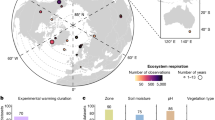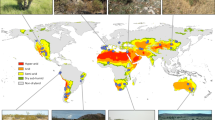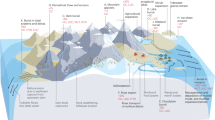Abstract
In the late Pleistocene, 97 genera of large animals went extinct, concentrated in the Americas and Australia1. These extinctions had significant effects on ecosystem structure2, seed dispersal3 and land surface albedo4. However, the impact of this dramatic extinction on ecosystem nutrient biogeochemistry, through the lateral transport of dung and bodies, has never been explored. Here we analyse this process using a novel mathematical framework that analyses this lateral transport as a diffusion-like process, and we demonstrate that large animals play a disproportionately large role in the horizontal transfer of nutrients across landscapes. For example, we estimate that the extinction of the Amazonian megafauna decreased the lateral flux of the limiting nutrient phosphorus by more than 98%, with similar, though less extreme, decreases in all continents outside of Africa. This resulted in strong decreases in phosphorus availability in eastern Amazonia away from fertile floodplains, a decline which may still be ongoing. The current P limitation in the Amazon basin may be partially a relic of an ecosystem without the functional connectivity it once had. We argue that the Pleistocene megafauna extinctions resulted in large and ongoing disruptions to terrestrial biogeochemical cycling at continental scales and increased nutrient heterogeneity globally.
This is a preview of subscription content, access via your institution
Access options
Subscribe to this journal
Receive 12 print issues and online access
$259.00 per year
only $21.58 per issue
Buy this article
- Purchase on Springer Link
- Instant access to full article PDF
Prices may be subject to local taxes which are calculated during checkout



Similar content being viewed by others
References
Barnosky, A. D., Koch, P. L., Feranec, R. S., Wing, S. L. & Shabel, A. B. Assessing the causes of Late Pleistocene extinctions on the continents. Science 306, 70–75 (2004).
Gill, J. L., Williams, J. W., Jackson, S. T., Lininger, K. B. & Robinson, G. S. Pleistocene Megafaunal collapse, novel plant communities, and enhanced fire regimes in North America. Science 326, 1100–1103 (2009).
Janzen, D. H. & Martin, P. S. Neotropical anachronisms—the fruits the gomphotheres ate. Science 215, 19–27 (1982).
Doughty, C. E., Wolf, A. & Field, C. B. Biophysical feedbacks between the Pleistocene megafauna extinction and climate: The first human-induced global warming? Geophys. Res. Lett. 37, L15703 (2010).
Kelt, D. A. & Van Vuren, D. H. The ecology and macroecology of mammalian home range area. Am. Nat. 157, 637–645 (2001).
Demment, M. W. & Vansoest, P. J. A nutritional explanation for body-size patterns of ruminant and nonruminant herbivores. Am. Nat. 125, 641–672 (1985).
Hutchinson, G. E. Survey of Contemporary Knowledge of Biogeochemistry Vol. 3 (Pemberley Books, 1950).
Mcnaughton, S. J. Ecology of a grazing ecosystem—the Serengeti. Ecol. Monogr. 55, 259–294 (1985).
Okubo, A. & Levin, S. A. Diffusion and Ecological Problems: Modern Perspectives 2nd edn (2001).
Stevenson, P. R. & Guzman-Caro, D. C. Nutrient transport within and between habitats through seed dispersal processes by woolly monkeys in North–Western Amazonia. Am. J. Primatol. 72, 992–1003 (2010).
Abbas, F. et al. Roe deer may markedly alter forest nitrogen and phosphorus budgets across Europe. Oikos (2012).
Peters, R. H. The Ecological Implications of Body Size (Cambridge Univ. Press, 1986).
Kaspari, M., Yanoviak, S. P. & Dudley, R. On the biogeography of salt limitation: A study of ant communities. Proc. Natl Acad. Sci. USA 105, 17848–17851 (2008).
Barnosky, A. D. & Lindsey, E. L. Timing of Quaternary megafaunal extinction in South America in relation to human arrival and climate change. Quat. Int. 217, 10–29 (2010).
MacFadden, B. J. Diet and habitat of toxodont megaherbivores (Mammalia, Notoungulata) from the late Quaternary of South and Central America. Quat. Res. 64, 113–124 (2005).
Mahowald, N. M. et al. Impacts of biomass burning emissions and land use change on Amazonian atmospheric phosphorus cycling and deposition. Glob. Biogeochem. Cycles 19, Gb4030 (2005).
Richey, J. E. & Victoria, R. L. in Interactions of C, N, P, and S Biogeochemical Cycles and Global Change (eds Mackenzie, F. T., Wollast, R. & Chou, L.) 123–140 (Springer, 1993).
Higgins, M. A. et al. Geological control of floristic composition in Amazonian forests. J. Biogeogr. 38, 2136–2149 (2011).
Hess, L. L., Melack, J. M., Novo, E. M. L. M., Barbosa, C. C. F. & Gastil, M. Dual-season mapping of wetland inundation and vegetation for the central Amazon basin. Remote Sens. Environ. 87, 404–428 (2003).
Furch, K. & Klinge, H. Chemical relationships between vegetation, soil and water in contrasting inundation areas of Amazonia. Spec. Publ. Br. Ecol. Soc. 189–204 (1989).
Quesada, C. A. et al. Variations in chemical and physical properties of Amazon forest soils in relation to their genesis. Biogeosciences 7, 1515–1541 (2010).
Fyllas, N. M. et al. Basin-wide variations in foliar properties of Amazonian forest: Phylogeny, soils and climate. Biogeosciences 6, 2677–2708 (2009).
Doughty, C. E. The development of agriculture in the Americas: An ecological perspective. Ecosphere 1http://dx.doi.org/10.1890/ES10-00098.1 (2010).
Doughty, C. E. & Field, C. B. Agricultural net primary production in relation to that liberated by the extinction of Pleistocene mega-herbivores: an estimate of agricultural carrying capacity? Environ. Res. Lett. 5, 044001 (2010).
Robertson, G. P. & Vitousek, P. M. Nitrogen in agriculture: Balancing the cost of an essential resource. Annu. Rev. Env. Resour. 34, 97–125 (2009).
Mcnaughton, S. J., Oesterheld, M., Frank, D. A. & Williams, K. J. Ecosystem-level patterns of primary productivity and herbivory in terrestrial habitats. Nature 341, 142–144 (1989).
Rees, P. A. Gross assimilation efficiency and food passage time in the African elephant. Afr. J. Ecol. 20, 193–198 (1982).
Carbone, C., Cowlishaw, G., Isaac, N. J. B. & Rowcliffe, J. M. How far do animals go? Determinants of day range in mammals. Am. Nat. 165, 290–297 (2005).
Kleiber, M. Body size and metabolic rate. Physiol. Rev. 27, 511–541 (1947).
Damuth, J. Interspecific allometry of population-density in mammals and other animals—the independence of body-mass and population energy-use. Biol. J. Linn. Soc. 31, 193–246 (1987).
Acknowledgements
We thank A. Barnosky and E. Gloor for comments as well as S. Levin, J. Murray and E. Lindsey for advice. C.E.D. was supported by the Gordon and Betty Moore Foundation and Geocarbon. A.W. is supported by the Carbon Mitigation Initiative of the Princeton Environmental Institute. Y.M. is supported by the Jackson Foundation and an ERC Advanced Investigator grant.
Author information
Authors and Affiliations
Contributions
C.E.D. developed the original idea of the paper. C.E.D., Y.M. and A.W. developed the mathematical framework and C.E.D. and A.W. ran the models. C.E.D. led the writing of the paper with contributions from Y.M. and A.W.
Corresponding author
Ethics declarations
Competing interests
The authors declare no competing financial interests.
Supplementary information
Supplementary Information
Supplementary Information (PDF 1364 kb)
Rights and permissions
About this article
Cite this article
Doughty, C., Wolf, A. & Malhi, Y. The legacy of the Pleistocene megafauna extinctions on nutrient availability in Amazonia. Nature Geosci 6, 761–764 (2013). https://doi.org/10.1038/ngeo1895
Received:
Accepted:
Published:
Issue Date:
DOI: https://doi.org/10.1038/ngeo1895
This article is cited by
-
Meta-analysis shows that wild large herbivores shape ecosystem properties and promote spatial heterogeneity
Nature Ecology & Evolution (2024)
-
Long-term concentration of tropical forest nutrient hotspots is generated by a central-place apex predator
Scientific Reports (2023)
-
Collapse of the mammoth-steppe in central Yukon as revealed by ancient environmental DNA
Nature Communications (2021)
-
Potential CO2 removal from enhanced weathering by ecosystem responses to powdered rock
Nature Geoscience (2021)
-
Oilbirds disperse large seeds at longer distance than extinct megafauna
Scientific Reports (2021)



